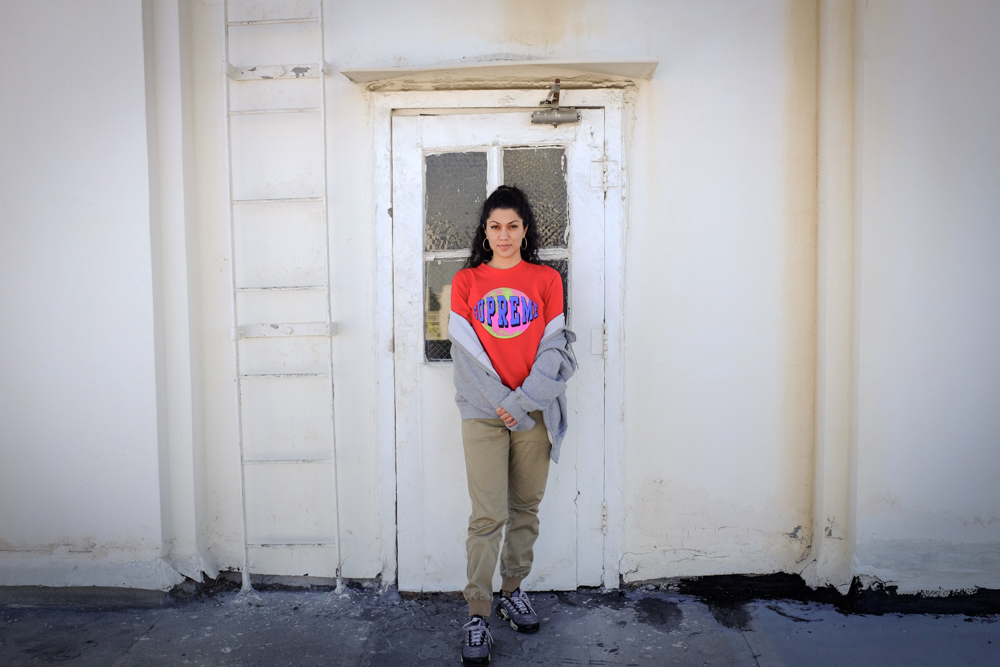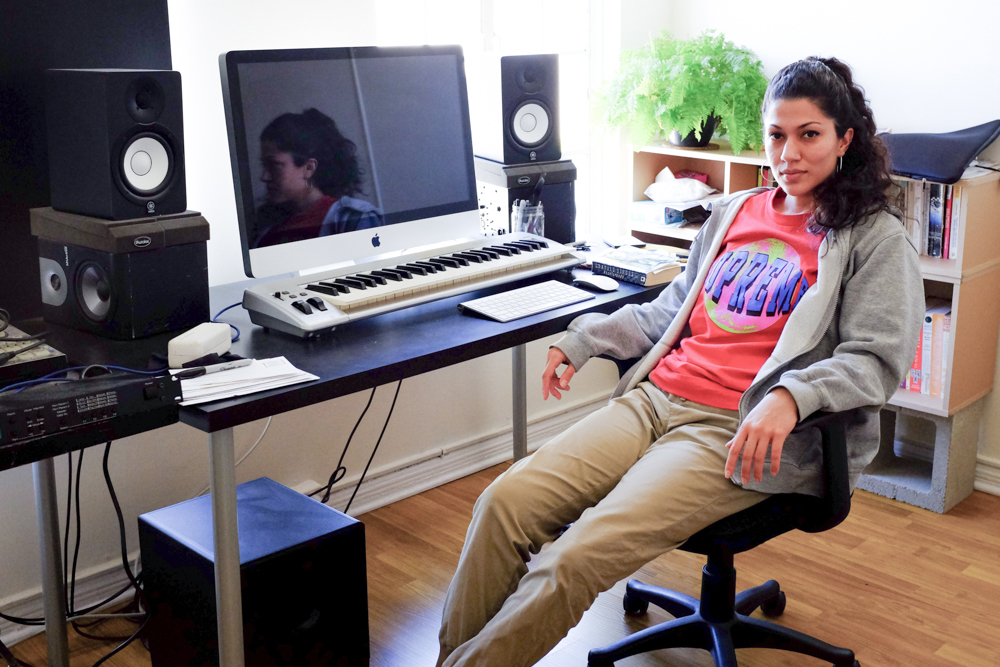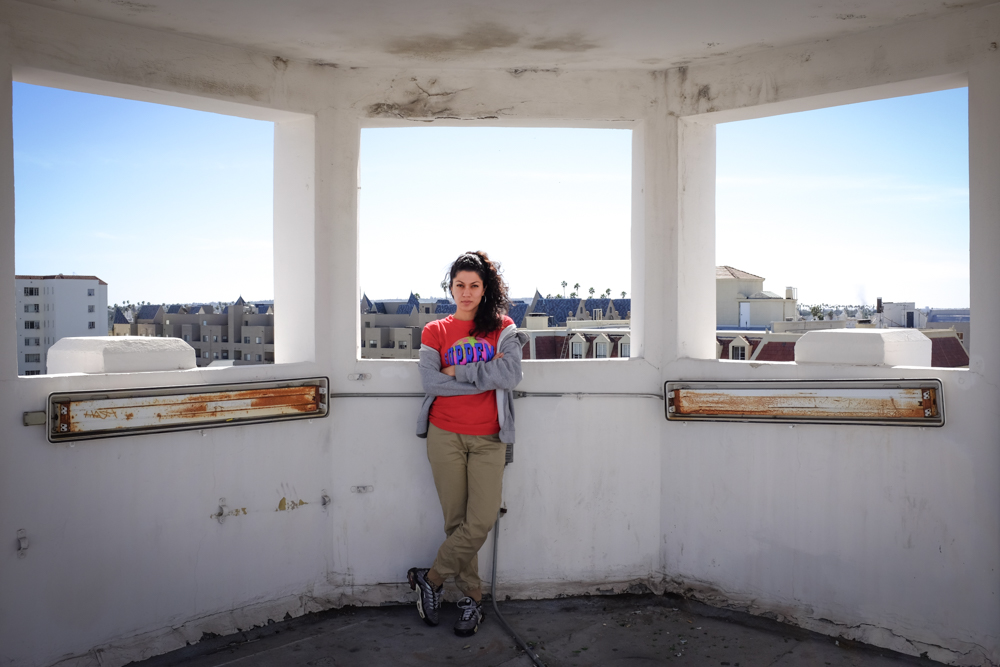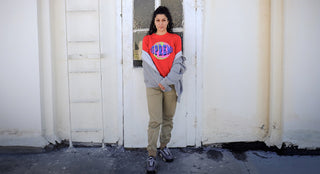In her 2005 book of essays, Transparent creator Jill Soloway details “an elemental nausea” about her gender, arising from “a truth I wanted to hide from: that being a woman meant being watched. I wanted to be a watcher.”
Last Wednesday, Los Angeles DJ and electronic musician Asma Maroof (aka MA NGUZU and ASMARA and MA DJ) tells me that when touring as duo Nguzunguzu, people always assumed she was the singer. Sadly, this anecdote didn’t surprise me. In 2014, The FADER wrote that less than 5% of music producers and engineers are women. Historically, female musicians are known for being in front of the microphone—in Soloway’s terms: watched.
As a music journalist, I’ve primarily written about men. My friend and writer Becca Wild recently said to me: “I think that women making art is radical: it crosses the line from ‘receiving’ to ‘making,’ to putting something into the world which is real and stands for itself.” I want to tell the stories of the brave women who undertake this radical act. And in Los Angeles, a city known for eschewing tradition and a strong artistic presence, there is no shortage of said women, and no better example than Asma Maroof.

I arrive at the Koreatown apartment and studio Asma shares with creative collaborator and boyfriend Daniel Pineda on a sunny Los Angeles afternoon. We initially plan to meet at 4 p.m., but Asma emails me to ask if we can do 2:30 instead because she wants to go to yoga afterwards. I text her when I arrive and she responds almost immediately: “coming!!” As I wait, I sit in the sun and admire her palatial white Art Deco building surrounded by tall, swaying palms.
Soon Asma swings open the front door to greet me. She seems surprised when I reach out to shake her hand (I guess this isn’t the obvious way to greet a DJ superstar) and then takes me inside. As we ride up the rattling elevator, I take in Asma’s outfit, which matches her uber-cool demeanor. She’s wearing tan joggers, a red Supreme shirt, a grey hoodie, leopard print socks, and Adidas slide sandals. Her curly black hair is half-up, revealing hoop earrings, and her face is free of make up—natural, aside from two swipes of winged eyeliner.
The minimalist, angelically-lit one-bedroom houses two music stations and lots of plants (Asma tells me she inherited her father’s green thumb). In the bedroom, I type notes on a couch in between a mattress and a massive Mac computer, a keyboard, and speakers. Sitting on the chair in front the set-up, Asma begins telling me about how she got into music. While she’d played violin her whole life, she didn’t start experimenting with electronic music until she bought a 1990s Pioneer CDJ for five dollars at a yard sale. She was living in Chicago at the time, studying visual art and film at the School of the Art Institute of Chicago (SAIC). After messing around with the CDJ at home all summer, she began bringing it to John Corbett’s musical improv class that fall. She said her classmates used to make fun of her: “Oh, Asma is bringing her VCR to class again.” She laughs. But Asma looks back fondly at her first experience making electronic loops before an audience.

Asma soon began jamming with Brenmar, a current Fool’s Gold artist whom she met at around the time she met Daniel. Brenmar owned a lot of equipment, the most memorable of which was an Alesis synthesizer that Asma ended up buying for herself. She took the Alesis on a road trip with Daniel, on which she tells me, matter-of-factly: “That’s when we made our first thirty tracks.” As collaborators, the couple calls themselves Nguzunguzu, with Asma under the moniker MA and Daniel as NA. Asma describes the duo’s unique name as “another college thing that stuck.” In a class on Polynesian art, Asma learned about figureheads that 19th century Solomon Islanders planted in their war canoes to ward off evil spirits. Asma was most drawn to the word itself. “It’s like a sound effect,” she says, before repeating it twice—”nguzu nguzu, nguzu ngzuzu”—and demonstrating its euphonious nature. “Me and Daniel also both like z’s.”
Asma speaks very casually about her work, perhaps downplaying its cultural significance. Last year, the LA Times named Fade to Mind, the collective and record label with which Nguzunguzu is associated, among “the most influential projects in L.A. underground music.” The group of artists, which also includes Kingdom, Kelela, and Total Freedom, has established itself by throwing innovative nights like Wildness—a radically inclusive party championed the queer community—collaborating with art museums, and staying true to their signature style of “eerie, electronic club music.” (According to the LA Times piece, Asma once had to tell a “very well-known singer”: “OK, maybe I’m just too dark for you.”) But the crew’s once-niche blend of what The Quietus called “party music with a brutalist edge” has recently seeped into the mainstream. “Fade to Mind’s murky mood isn’t fringe anymore,” the LA Times wrote, “it’s impacting everyone from Tinashe to Beyonce,” defining “L.A.’s late nights and radio hits alike.”
In addition to infusing darkness into popular dance music, the Fade to Mind crew, and Nguzunguzu in particular, are also known for their “mastery of a certain web-age logic of ceaseless discovery and seamless re-contextualization,” says The Quietus‘s interview with the duo. A 2010 Nguzunguzu mixtape, for example, remixes the Art of Noise classic “Moments in Love” twenty-four times in unexpected genres “ranging from ghetto house to cumbia to jungle.” A globally conscious, post-Internet eclecticism animates all of Fade to Mind’s projects. When asked by a label to “put together a compilation of ‘[his] scene,’’’ Fade to Mind’s Ashland Mines aka Total Freedom told Interview Magazine that he just laughed: “That music isn’t a scene, it doesn’t even exist! The music I play, generally, is made by 15-year-old kids in Portugal that I don’t even know and who don’t give a shit about me.”
While Asma and Daniel have enjoyed a lengthy career as a duo, they’re currently focused on releasing solo work (Daniel just released his Cellar EP as NA). In 10 years as a musician, Asma has released five EPs as Nguzunguzu, spent two years as M.I.A.’s touring DJ, and released a self-titled album with three other musicians as Future Brown. But aside from the improv days, Asma’s current project is her first stab at solo work.
As I tend to associate most creative pursuits with solitude, I’m surprised that Asma has never made music by herself until now. Her career, instead, seems to have taken a more synergistic and collaborative trajectory. She moved from Chicago to L.A. because it was sunny and her friends were here. Her music career took off, she tells me, because she “started playing music at parties and caught a vibe.” She describes the formation of her production quartet Future Brown (with Daniel, Fatima Al Quadiri, and J-Cush) as—simply—“organic.” Most of her stories involve groups. When I ask her about memorable moments surrounding Future Brown, she tells me about wanting Kid Ink on the album.
“He wasn’t, like, a thing then,” she laughs. “I got his mixtape from the weed shop.”
Asma then describes driving to the airport to pick up Fatima and Jamie (J-Cush) and blasting the mixtape enthusiastically on the ride back. Unfortunately, Kid Ink was among only a few on the group’s dream list that didn’t make the record (also missing: Soulja Boy and Jeremih). But the album Future Brown suffers from no dearth of stardom: it includes features from Timbaland protege Tink, Chicago post-drill duo Sicko Mobb, and L.A. R&B darling Kelela. However it was a collaboration with Chicago rapper Shawnna that the group was most excited about. “Shawnna was a big deal for us coming from Chicago—she’s a legend.” Asma explains the experience of first listening to Shawnna’s vocal file with the group: “It was pure ecstasy. We couldn’t even listen because we were just screaming after the first word she uttered on the beat.”
And in typical Asma fashion, she describes Fade to Mind as a “family,” as more of a crew than anything else. While the label was officially founded by Will Boston (Prince Will) and Ezra Rubin (Kingdom), Asma refers to it as “our label.” “I mean,” she pauses, “I wasn’t there giving birth, pulling out the baby with my bare hands.” She laughs. “Maybe don’t write that.” But how can I not? The analogy is too perfect.
When I ask her about the difficulties of being a woman in the industry, she says she tries not to think about it too much. The upside of being in a boys’ club, she tells me, is that there is a special fascination and allure that come with being a rarity. The downside is that it’s easy to feel isolated in a world that, during her “formative years,” Asma never believed was open to her. But since coming to L.A., Asma has found solace in meeting like-minded women like Fatima, M.I.A., Venus X, and Kelela. And in DJing for M.I.A. from 2009 to 2011, Asma, for the first time saw electronic music as a potential career path. While her early experiences playing music involved underground parties and small audiences, with M.I.A. she was performing solo sets in front of 60,000 people—on CDs. “Oh wait,” she recalls thinking, “I can perform festivals in Europe doing this.”
Asma also speaks fondly about being asked to be a panelist at a conference put on by WAM, a woman-owned studio in San Francisco that teaches engineering and music software classes to young girls. She finds it immensely important that women realize that music production is not off-limits to them. Finally, Asma has been inspired by her mother, who also works in a male-dominated industry, albeit a different one: mathematics. Asma’s parents both worked at NASA.
“Oh, so they’re geniuses,” I say.
“They’re prett-y smart,” she says with a shy smile. While her mother doesn’t totally understand what Asma is doing (both of her siblings are doctors), Asma believes that her career is not markedly different from her mother’s. “Electronic musicians,” she tells me, “are basically engineers.”

While Asma describes the early stages of her creative process as “flowy”—she’ll get inspired by anything from a song to a “really good glass of wine”—the latter portion is predominantly technical. In the editing stages, Asma becomes cerebral, favoring over-analysis. “I forget that I can ask people for help,” she says, explaining that she’s been grateful to be able to call on her Fade to Mind and Future Brown colleagues. A small suggestion, she tells me, can take her work in a whole new direction. When she gets stuck, she’ll phone a friend or let it sit for a week. Taking a step away helps her come back with fresh eyes.
Asma tells me her current EP is “fun and playful, with a sad tinge.”
“Sounds perfect,” I say.
She laughs. “The key word is playful.”
When I can tell she’s tired of being interrogated, I ask if she received my email about my possibly taking a few photos. She didn’t.
“Don’t worry about it,” I say.
“No, it’s fine.” Asma says. “Just give me a few minutes.” She stands up and leaves the room. “We can go on my roof,” she calls to me from the bathroom.
Asma emerges just moments later. On the way out, she trades her Adidas slides for a pair of sneakers. She leads me through the hallway to a rusty white fire escape.
“You aren’t scared of heights, are you?” She asks when she’s already half-way up the ladder to the roof.
I shrug, minimizing my fear as I feel myself shake slightly in the wind. I throw my camera into my bag and begin to climb, trying my best to look only at the rungs of the ladder and not at the six stories between me and the pavement.
The roof is sprawling and gorgeous. “Totally worth it,” I say as I take in the views, feeling slightly steadier. I snap photos of Asma in numerous fierce poses on three of the roof’s edges as we chat about L.A. neighborhoods and what it’s like to work with her boyfriend. I think of something Sleater Kinney rocker Carrie Brownstein wrote in her recent memoir, Hunger Makes Me a Modern Girl: “We were never trying to deny our femaleness. Instead, we wanted to expand the notion of what it means to be female. The notion of ‘female’ should be so sprawling and complex that it becomes divorced from gender itself.”
Instead of sharing Soloway’s urge to hide from her gender, Asma belongs to a new wave of women that’s expanding the word’s meaning, turning it into something that includes singers and producers, homemakers and mathematicians, the watched and the watchers. And what is more radical than that?
Who Run LA? Asma Maroof.
***
Follow Asma on Twitter @MA_NGUZU and Soundcloud, and Nguzunguzu on Soundcloud.
Photos by Anna Dorn.

